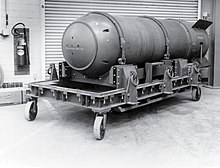1958 Tybee Island mid-air collision

A Mk 15 nuclear bomb of the type lost when jettisoned after the collision
|
|
| Midair Collision summary | |
|---|---|
| Date | February 5, 1958 |
| Summary | Midair collision |
| Site |
Tybee Island, Georgia, United States 32°0′N 80°51′W / 32.000°N 80.850°WCoordinates: 32°0′N 80°51′W / 32.000°N 80.850°W |
| First aircraft | |
| Type | Boeing B-47 |
| Operator | United States Air Force |
| Registration | 51-2349 |
| Fatalities | 0 |
| Second aircraft | |
| Type | F-86 Sabre |
| Operator | United States Air Force |
| Crew | 1 |
| Survivors | 1 |
The Tybee Island B-47 crash was an incident on February 5, 1958, in which the United States Air Force lost a 7,600-pound (3,400 kg) Mark 15 nuclear bomb in the waters off Tybee Island near Savannah, Georgia, United States. During a practice exercise, an F-86 fighter plane collided with the B-47 bomber carrying the bomb. To protect the aircrew from a possible detonation in the event of a crash, the bomb was jettisoned. Following several unsuccessful searches, the bomb was presumed lost somewhere in Wassaw Sound off the shores of Tybee Island.
The B-47 bomber was on a simulated combat mission from Homestead Air Force Base in Florida. It was carrying a single 7,600-pound (3,400 kg) bomb. At about 2:00 AM, an F-86 fighter collided with the B-47. The F-86 crashed, after the pilot ejected from the plane. The damaged B-47 remained airborne, plummeting 18,000 feet (5,500 m) from flight level 380 (38,000 feet (12,000 m)) when Major Richardson regained flight control.
The crew requested permission to jettison the bomb, in order to reduce weight and prevent the bomb from exploding during an emergency landing. Permission was granted, and the bomb was jettisoned at 7,200 feet (2,200 m) while the bomber was traveling at about 200 knots (370 km/h). The crew did not see an explosion when the bomb struck the sea. They managed to land the B-47 safely at the nearest base, Hunter Air Force Base. The pilot, Colonel Howard Richardson, was awarded the Distinguished Flying Cross after this incident.
...
Wikipedia
